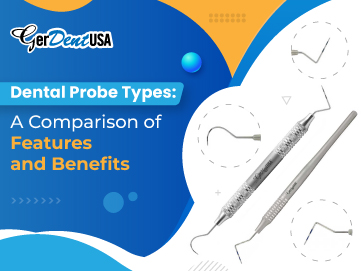Delicate dental surgeries, such as implant placements, tooth extractions, and root canals, require precision-crafted instruments to ensure patient comfort and accuracy.
Forceps and Hemostats are specialized instruments required in various medical and dental procedures.
However, understanding the difference between them is important in order to choose the right instrument for optimal results.
Here, we will discuss forceps vs hemostat in detail. We’ll highlight their differences, types, uses, materials, and more.
What Are Forceps?
Forceps are medical-grade dental instruments designed for manipulating tissues, holding objects, and dissecting structures during oral surgeries.
These instruments usually have two slender shanks with serrated or non-serrated jaws at the tip. They also come in different shapes to cater to surgeons' diverse needs, such as the hand tweezer forceps and Allison tweezer tissue forceps. Both are handheld instruments but have different designs.
Types of Forceps
The different types of dental forceps are discussed in detail below:
Allison Tweezer Tissue Forceps TFS 15cm
The Allison Tweezer Tissue Forceps TFS 15 cm are precision-crafted surgical forceps used for stabilizing and grasping delicate tissues during suturing. The instrument’s ideal length is 15 cm, and its atraumatic design helps dentists perform suturing with enhanced precision and minimal tissue trauma. These instruments usually come in small, medium, and larger sizes.
Atraumatic Debakey Tweezer Tissue Forceps Curved 18cm
The Atraumatic Debakey Tweezer Tissue Forceps are handheld dental instruments used to manipulate soft tissues. These instruments are ideally used during suturing procedures. The forceps curved tips help the surgeons treat hard-to-reach areas. This instrument also comes in multiple variations and sizes to accommodate the diverse needs of dentists.
Tweezer Tissue Forceps 11.5cm Slightly Angled Tip
This instrument features a slightly angled tip for atraumatic handling and stabilization of tissues during dental surgical procedures. It is 11.5 cm long and manufactured from German Stainless steel for longevity. The lightweight instrument helps in effective tissue manipulation with optimal grip.
Tweezer Tissue Forceps Micro Suture 16cm
These dental forceps have an overall length of 16 cm and are specially designed to handle, stabilize, and manipulate tissues during dental procedures. Their tiny forceps offer an optimal grip, ensuring efficient tissue manipulation with minimal risk of complications and patient discomfort. This instrument comes in multiple sizes.
What Is a Hemostat?
The hemostat, also known as the hemostatic forceps, is a dental surgical instrument that clamps down on the blood vessels to control bleeding during surgery.
Hemostat instruments usually feature finger rings or plier design handles. They have a ratchet mechanism, allowing for a secure and optimal grip.
Depending on their specified purpose, the jaws of the instruments can be either serrated or non-serrated.
Types of Hemostats
The different types of hemostats are discussed in detail below:
Baby Mixter Hemostatic Forceps
The Baby Mixter Hemostatic Forceps are used to control blood vessels in obscured surgical areas. They are ergonomically manufactured from German Stainless steel for optimal performance and resistance to corrosion. These forceps feature serrated jaws and curved tips that offer secure grasping with minimal tissue trauma.
Crile Hemostatic Forceps
The Crile Hemostatic Forceps are versatile dental instruments used to control blood in various surgical areas. They feature a ratchet mechanism for secure clamping of blood vessels before ligation and cauterization. This instrument usually comes in two different patterns: straight and curved.
Halsted Mosquito Forceps
The Halsted Mosquito Forceps are another specialized type of hemostat. They are specially designed to hold small blood vessels to control bleeding during delicate dental surgical procedures.
These high-quality instruments feature a firm grip, ergonomic handle, and serrated jaws for optimal performance.
They are also available in multiple variations.
Kocher Hemostatic Forceps
The Kocher Hemostatic Forceps are ergonomically designed hemostats. Their stainless steel body and horizontal serrations on the jaws ensure optimal control when performing delicate dental surgeries.
Specially utilized for clamping blood vessels, this instrument features 1 X 2 teeth at the tip to ensure a firm grip.
Overview of Forceps Vs Hemostats
Here is an overview of their key differences:
| Features | Forceps | Hemostats |
|---|---|---|
| Structural features | Slender arms with gripping jaws | Locking pliers or ring scissors |
| Purpose | Grasping, holding, and manipulating tissues | Clamping and control of blood flow |
| Locking Mechanism | May have | Present in all hemostats |
| Jaws | They may or may not be serrated |
They may or may not be serrated |
What Are Forceps and Hemostats Manufactured From?
Both forceps and hemostats are often manufactured from medical-grade Stainless steel. This material ensures durability, resistance to corrosion, and the ability to withstand repeated sterilization cycles.
What Is the Most Suitable Method for Sterilizing Hemostats and Forceps?
Both forceps and hemostats are sterilizable and the best sterilization method for these two instruments is autoclaving.
This sterilization process is discussed in detail below:
Autoclaving
Autoclaving is also known as steam sterilization. It’s the process of using high-pressure steam to eliminate bacteria, viruses, spores, and other microorganisms.
For sterilizing forceps and hemostats, autoclaving uses 121°C to 134°C high-pressure steam to effectively eliminate all microorganisms for around 15 to 30 minutes.
This process offers a quick turnaround time, making it ideal for both forceps and hemostats.
However, it’s suggested to read the provided manual or consult with the autoclave manufacturer before using the machine.
To Wrap Up!
In this guide on forceps vs hemostats, you must have learned that both instruments have similar structural features but are used for different purposes.
Forceps help manipulate tissues, while hemostats are utilized to clamp the blood vessels during delicate dental surgeries.
In order to choose the right instrument for performing optimal surgeries, it’s important to understand the differences between forceps and hemostats.
Explore our catalog to get medical-grade forceps and hemostats.
We offer German Stainless steel instruments that adhere to FDA guidelines, making them ideal for performing oral surgeries with precision and accuracy.
FAQs
1. What is another name for a hemostat?
Hemostat is also known as arterial forceps and surgical clamp. These are precision-crafted instruments used for clamping blood vessels to stop bleeding during dental surgeries.
2. What are forceps and hemostats made of?
Forceps and hemostats are often crafted from stainless steel for longevity and corrosion resistance. This medical-grade material ensures that the instruments are sterilizable and offer optimal performance.
3. How do hemostats control bleeding?
Hemostats clamp blood vessels with their jaws, constricting the vessel's inner opening and reducing or completely stopping blood flow.






